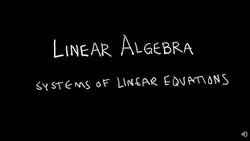
Linear Algebra (Entire Course) 
Linear Algebra is a course that covers topics such as systems of linear equations, solving systems of linear equations in augmented matrices using row operations, row reduction and echelon forms, and solution sets. It also covers topics such as vector spaces, linear transformations, and matrices. ▼
ADVERTISEMENT
Course Feature
![]() Cost:
Cost:
Free
![]() Provider:
Provider:
Youtube
![]() Certificate:
Certificate:
Paid Certification
![]() Language:
Language:
English
![]() Start Date:
Start Date:
On-Demand
Course Overview
❗The content presented here is sourced directly from Youtube platform. For comprehensive course details, including enrollment information, simply click on the 'Go to class' link on our website.
Updated in [February 21st, 2023]
What does this course tell?
(Please note that the following overview content is from the original platform)
Linear Algebra 1.1.1 Systems of Linear Equations.
Linear Algebra 1.1.2 Solve Systems of Linear Equations in Augmented Matrices Using Row Operations.
Linear Algebra 1.2.1 Row Reduction and Echelon Forms.
Linear Algebra 1.2.2 Solution Sets and Free Variables.
Linear Algebra 1.3.1 Vector Equations.
Linear Algebra 1.3.2 Linear Combinations.
Linear Algebra 1.4.1 The Matrix Equation Ax=b.
Linear Algebra 1.4.2 Computation of Ax.
Linear Algebra 1.5.1 Homogeneous System Solutions.
Linear Algebra 1.5.2 Non-Homogeneous System Solutions.
Linear Algebra 1.6.1 Applications of Linear Systems - Economic Sectors.
Linear Algebra 1.6.2 Applications of Linear Systems - Network Flow.
Linear Algebra 1.7.1 Linear Independence.
Linear Algebra 1.7.2 Special Ways to Determine Linear Independence.
Linear Algebra 1.8.1 Matrix Transformations.
Linear Algebra 1.8.2 Introduction to Linear Transformations.
Linear Algebra 2.1.1 Matrix Operations - Sums and Scalar Multiples.
Linear Algebra 2.1.2 Matrix Operations - Multiplication and Transpose.
Linear Algebra 2.2.1 The Inverse of a Matrix.
Linear Algebra 2.2.2 Solving 2x2 Systems with the Inverse and Inverse Properties.
Linear Algebra 2.2.3 Elementary Matrices And An Algorithm for Finding A Inverse.
Linear Algebra 2.3.1 Characterizations of Invertible Matrices.
Linear Algebra 3.1.1 Introduction to Determinants.
Linear Algebra 3.1.2 Co-factor Expansion.
Linear Algebra 3.2.1 Properties of Determinants.
Linear Algebra 4.1.1 Vector Spaces.
Linear Algebra 4.1.2 Subspace of a Vector Space.
Linear Algebra 4.2.1 Null Spaces.
Linear Algebra 4.2.2 Column Spaces.
Linear Algebra 4.3.1 Linearly Independent Sets and Bases.
Linear Algebra 4.3.2 The Spanning Set Theorem.
Linear Algebra 4.5.1 The Dimension of a Vector Space.
Linear Algebra 4.5.2 Subspaces of a Finite Dimensional Space.
Linear Algebra 4.6.1 The Row Space.
Linear Algebra 4.6.2 Rank.
Linear Algebra 5.1.1 Eigenvectors and Eigenvalues.
Linear Algebra 5.1.2 More About Eigenvectors and Eigenvalues.
Linear Algebra 5.2.1 Determinants and the IMT.
Linear Algebra 5.2.2 The Characteristic Equation.
Linear Algebra 6.1.1 Inner Product, Vector Length and Distance.
Linear Algebra 6.1.2 Orthogonal Vectors.
Linear Algebra 6.2.1 Orthogonal Sets.
Linear Algebra 6.2.2 Orthogonal Projections.
Linear Algebra 6.3.1 Orthogonal Decomposition Theorem.
Linear Algebra 6.3.2 The Best Approximation Theorem.
Linear Algebra 6.5.1 Least Squares Problems.
We consider the value of this course from multiple aspects, and finally summarize it for you from three aspects: personal skills, career development, and further study:
(Kindly be aware that our content is optimized by AI tools while also undergoing moderation carefully from our editorial staff.)
Learners can learn a variety of topics from this Linear Algebra course. Firstly, they can learn about systems of linear equations and how to solve them using augmented matrices and row operations. Secondly, they can learn about vector equations, linear combinations, and the matrix equation Ax=b. Thirdly, they can learn about homogeneous and non-homogeneous system solutions, as well as applications of linear systems in economic sectors and network flow. Fourthly, learners can learn about linear independence, matrix transformations, and linear transformations.
In addition, learners can learn about matrix operations, such as sums, scalar multiples, multiplication, and transpose. They can also learn about the inverse of a matrix, elementary matrices, and an algorithm for finding an inverse. Furthermore, learners can learn about determinants, vector spaces, subspaces, null spaces, column spaces, linearly independent sets and bases, the spanning set theorem, and the dimension of a vector space.
Finally, learners can learn about eigenvectors and eigenvalues, determinants and the IMT, the characteristic equation, inner product, vector length and distance, orthogonal vectors, orthogonal sets, orthogonal projections, the orthogonal decomposition theorem, the best approximation theorem, and least squares problems.
[Applications]
Upon completion of this course, students should be able to apply the concepts of Linear Algebra to a variety of real-world problems. This includes the ability to solve systems of linear equations, understand vector equations, compute matrix transformations, calculate determinants, identify eigenvectors and eigenvalues, and use inner product, vector length, and distance. Additionally, students should be able to use orthogonal vectors, orthogonal sets, and orthogonal projections to solve problems. Finally, students should be able to use the best approximation theorem and least squares problems to solve problems.
[Career Paths]
From this course, learners can pursue a career in the following positions:
1. Data Scientist: Data Scientists use linear algebra to analyze large datasets and uncover patterns and trends. They use linear algebra to develop predictive models and algorithms to help businesses make better decisions. Data Scientists are in high demand and the job outlook is expected to grow significantly in the coming years.
2. Machine Learning Engineer: Machine Learning Engineers use linear algebra to develop algorithms and models that can be used to automate tasks and make decisions. They use linear algebra to create and optimize machine learning models and algorithms. The job outlook for Machine Learning Engineers is expected to grow significantly in the coming years.
3. Financial Analyst: Financial Analysts use linear algebra to analyze financial data and make predictions about the future. They use linear algebra to develop models and algorithms to help businesses make better decisions. The job outlook for Financial Analysts is expected to remain strong in the coming years.
4. Software Developer: Software Developers use linear algebra to develop software applications and systems. They use linear algebra to create algorithms and models that can be used to automate tasks and make decisions. The job outlook for Software Developers is expected to remain strong in the coming years.
Course Provider

Provider Youtube's Stats at AZClass
Over 100+ Best Educational YouTube Channels in 2023.
Best educational YouTube channels for college students, including Crash Course, Khan Academy, etc.
AZ Class hope that this free Youtube course can help your Linear Algebra skills no matter in career or in further education. Even if you are only slightly interested, you can take Linear Algebra (Entire Course) course with confidence!
Discussion and Reviews
0.0 (Based on 0 reviews)
Explore Similar Online Courses

Complete Augmented Reality (AR) Course with Unity and Vuforia (Complete AR tutorial for Unity)

Free Python Tutorials - Full Course for Beginners

Python for Informatics: Exploring Information

Social Network Analysis

Introduction to Systematic Review and Meta-Analysis

The Analytics Edge

DCO042 - Python For Informatics

Causal Diagrams: Draw Your Assumptions Before Your Conclusions

Whole genome sequencing of bacterial genomes - tools and applications

Linear Algebra: Help & Tutorials

Eigenvectors and Eigenvalues


Start your review of Linear Algebra (Entire Course)